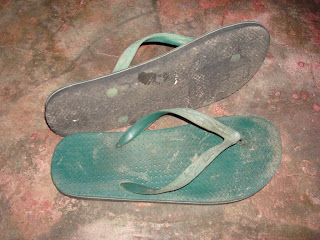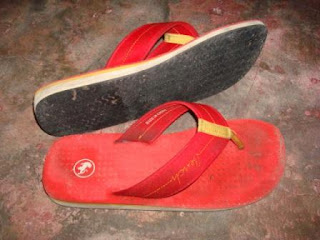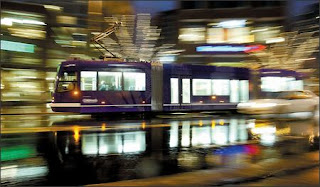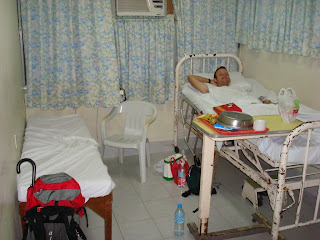The Philippines surely has among the highest percent of English speakers outside of the former British Empire (not including many of the northern European countries, like Sweden, where they speak English better than most Americans). The national language, Tagalog, is often referred to as “Taglish” for the amount of English that’s found its way in. The same could be said about Cebuano – listen to any conversation and you likely hear many English words peppered in. Beginning at an early age, science and mathematics are taught in English. Laws are written in English. Street signs are usually in English. MC’s at events usually speak in English (which is great for me!). Most official communication is in English, as are most daily newspapers, some Filipino television channels (in addition to the many English cable channels), and many radio stations. From this constant English exposure, many terms have developed that are English, or English-based, but are not found in American English. Note that many of the terms deal with technology that has been imported. For example:
Bringhouse (noun) – synonymous to takeout (US) or takeaway (UK) food. Typically you would acquire bringhouse at a fiesta or party, where there is always a huge amount of food and it is custom for guests to bring some home.
CP (noun) – cell phone. Not typically used in my area, where people just say “cell phone”, but I hear that this is common in Luzon.
LBM (noun) – Loose Bowel Movement. This is the proper, polite term for diarrhea, and is always referred to by the acronym. It can also apply to the texture of a single bowel movement, but this is less common. As a rare child who grew up referring to “BM” (“Mommy, I need to go BM!”) rather than any of the innumerable synonyms of this timeless human byproduct, I was delighted to learn of this term.
Load (noun) –pre-paid credits for your cell phone. Can be purchased through higher-denomination cards or in smaller amounts through electronic load (e-load), which is available from almost every business establishment in the country. Load can also be sent from one phone to another. Ex. “Can you send me some load?” “Go buy your own load”.
Lowbat (noun) – the state of having little to no power left in a battery-powered device, whether a phone, camera, computer, etc. Applies whether the device uses a rechargeable battery or disposables. Of all the Filipino English words, I recommend this one for adaption in the US the most. It’s just so much more efficient to point at a device and say “lowbat” than say “I need to charge my cell phone” or “I’m almost out of battery on my camera”.
Misscall (verb) – to call somebody’s cell phone and then immediately hang up after the first ring. (noun) – a missed telephone call that has been sent in the manner previously described. Misscalls are sometimes sent immediately before a text message, to ensure that the person is getting service and that the text message will be received. They are also sent on occasion to annoy, pester, or convey feelings of annoyance or abandonment.
Textmate (noun) – a person whom one corresponds with via text message on a regular basis. Often, but not always, refers to a person of romantic interest. Textmates can be acquired through random messaging or through in-person meeting, but they are not typically someone that is seen on a regular basis. Common texting topics may be your textmate’s current whereabouts and whether or not they have finished the meal corresponding to that time of day.
---UPDATE
If anybody has additional words to add, please post them in the comments. Here's an extra one now:
McDo (noun) - McDonald's. Pronounced "Mack Dough", this is the preferred way to refer to McDonald's, not "Mc D's", "Mickey D's" or any of the other variations. This is promoted by McDonald's itself, and their number is something like 284-MCDO. On a side note, McDo used to have a McRice burger, where rice patties were used instead of hamburger buns to hold the burger. It was delicious, but I only had it once, and now they've discontinued it. Sayang!
Liveband (noun) - refers to, obviously, a live band, but is more commonly used in place of the word "concert". It scarcely matters who the band is, but only that there are live musicians (which would typically be a cover band). Example: "Are you going to liveband tonight?"
Chickboy (noun) - A guy who has a lot of chicks. Among the favorite conversation topics of Filipino males when just sitting around talking. "Chickboy" does not refer to a male who has many feminine tendencies, although that obvious joke is often made about the chickboy in question.
I can't believe I forgot this one originally:
Comfort Room (noun) - More commonly referred to as "CR", this joins "WC" in Europe on the list of English-based acronyms about bathrooms. Or washrooms, restrooms, etc. - they're really all euphemisms, after all. But while the Comfort Room in your house may actually be comfortable (mine is), most CRs in public places are anything but, making this an especially ironic term. It is recommended that you have your own TP and soap, and quite frequently both a strong stomach and legs. A notable exception is McDo, which has spotless CRs.
Thursday, January 31, 2008
Saturday, January 19, 2008
Akong Tsinellas - An ode to flip-flops
Flip-flops are a way of life here. The typical Filipino footwear, whether it is for a trip to the market, playing in a basketball game, hanging out at home, or walking along the beach, is the flip-flop. In the Philippines, they are not called flip-flops, but either “slippers” (like in Hawaii) or “tsinellas” (pronounced ‘chinillas’), which is the local word. (The word “thong” is not used here, but is that used anywhere now in reference to these shoes? That was what I grew up calling them. Thanks a lot, Sisqo.) I was never a big proponent of flip flops back home. For most of the year, it was impractical, unless you were some Californian import - they tended to wear them in the most ridiculous temperatures. Also, growing up, I detested the feeling of something between my toes. As a result, I never really got into flip flops until the later years of college when I discovered the joy of Reef sandals, and even then, only on the most pleasant of days that didn’t require too much walking.
However, since coming here, my feet have toughened up and I have become a flip-flop fanatic. I wear them almost all the time, even when cultural or professional standards probably dictate that I shouldn’t. For instance, at work, in meetings with Peace Corps officials, and on national television. While I subscribe to the theory that, in the absence of proper dress shoes, flip-flops better complete an outfit of khaki pants and a dress shirt than a pair of athletic shoes, that is not the common feeling here. Not that I don’t have dress shoes, but really, who wants to wear them in this heat? So I persist, hoping that I’ll get away with it and not offend anybody, and that my reputation will not take too slobby of a hit.
I came here with one pair of flip-flops, and have since purchased three pairs (actually four, the fourth pair bought in a pinch when another pair was causing unbearable pain, but I’ve since given them away because they were comically small on me). It would give me great happiness to describe my tsinellas to you, and so I will:
 The Old Trusty Reefs
The Old Trusty Reefs
These were a graduation gift, and they are over one and a half years old. They saw their debut in Europe and have traveled many miles since. They’re showing their wear, most of which was obtained through almost daily use since arriving in the Philippines. Letters are falling off, some of the material is coming off, I’ve had to sew one of the “thong” parts back together, and I need to sew the other one soon. These shoes feature a bottle opener on the bottom, which is kind of a gross idea to begin with, but is always a novelty conversation item (I once amazed a group of Australians with this trick in Berlin). But now, I’ve knowingly stepped in far too many foreign substances (read: different kinds of animal poo) to ever use this feature again. Still, they are my favorites, the sturdiest, and the most comfortable. I could probably only replace them with a newer version of themselves.
 The Spartan Greens
The Spartan Greens
These are the standard flip-flops that most Filipinos wear. Cheap, plain, and practical, and fittingly, the brand name is Spartan. I purchased them on one of my first days at my original host family, at the small market in town, for wearing in the house and the bathroom. They are size 11, and while my whole foot fits on them, they’re not as big as I would like, so I continue to use them as house slippers.
 The Brazil “Havaianas”
The Brazil “Havaianas”
Anybody who has read this far on an inane post about flip-flops is likely to know what Havaianas are – the wildly popular, relatively cheap brand that usually has a little Brazilian flag on the above-foot part (does anybody know what that’s called? Writing this post has made me realize my lack of knowledge on flip-flop terminology). These are often imitated here – as "Havanas", or Havaianas - just not the real thing, probably - like mine. I purchased these shortly after moving to my current house, because I wanted to keep the plain green ones for my room, and I wanted another pair to wear while puttering around between my room and the main house. They’re still too small for me (size 11), but they’re very comfortable anyway, so I mostly wear them when I’m at home. The bottom used to be all green except for the yellow diamond of the Brazilian flag, but I played basketball in them one time, and the green wore away into the funny footprint design you see today.
 The Red Benches
The Red Benches
I got these ones most recently, partially to provide relief to my sometimes-smelly Reefs, and partially because they were a legit size 12, which is very hard to come by here. They’re from Bench, which is like the Philippine version of the Gap, and are sturdier than the previous, cheaper two. I wore them a lot when I first bought them, but they pick up dirt very easily and no longer look as fashionable, so it’s harder for me to get away with wearing them to work, etc., and I usually wear my Brazils around the house. For now, they’re riding the pine while I try to find a way to work them into the rotation. (Get it? ‘Bench’ed! Hah!)
However, since coming here, my feet have toughened up and I have become a flip-flop fanatic. I wear them almost all the time, even when cultural or professional standards probably dictate that I shouldn’t. For instance, at work, in meetings with Peace Corps officials, and on national television. While I subscribe to the theory that, in the absence of proper dress shoes, flip-flops better complete an outfit of khaki pants and a dress shirt than a pair of athletic shoes, that is not the common feeling here. Not that I don’t have dress shoes, but really, who wants to wear them in this heat? So I persist, hoping that I’ll get away with it and not offend anybody, and that my reputation will not take too slobby of a hit.
I came here with one pair of flip-flops, and have since purchased three pairs (actually four, the fourth pair bought in a pinch when another pair was causing unbearable pain, but I’ve since given them away because they were comically small on me). It would give me great happiness to describe my tsinellas to you, and so I will:
These were a graduation gift, and they are over one and a half years old. They saw their debut in Europe and have traveled many miles since. They’re showing their wear, most of which was obtained through almost daily use since arriving in the Philippines. Letters are falling off, some of the material is coming off, I’ve had to sew one of the “thong” parts back together, and I need to sew the other one soon. These shoes feature a bottle opener on the bottom, which is kind of a gross idea to begin with, but is always a novelty conversation item (I once amazed a group of Australians with this trick in Berlin). But now, I’ve knowingly stepped in far too many foreign substances (read: different kinds of animal poo) to ever use this feature again. Still, they are my favorites, the sturdiest, and the most comfortable. I could probably only replace them with a newer version of themselves.
These are the standard flip-flops that most Filipinos wear. Cheap, plain, and practical, and fittingly, the brand name is Spartan. I purchased them on one of my first days at my original host family, at the small market in town, for wearing in the house and the bathroom. They are size 11, and while my whole foot fits on them, they’re not as big as I would like, so I continue to use them as house slippers.
Anybody who has read this far on an inane post about flip-flops is likely to know what Havaianas are – the wildly popular, relatively cheap brand that usually has a little Brazilian flag on the above-foot part (does anybody know what that’s called? Writing this post has made me realize my lack of knowledge on flip-flop terminology). These are often imitated here – as "Havanas", or Havaianas - just not the real thing, probably - like mine. I purchased these shortly after moving to my current house, because I wanted to keep the plain green ones for my room, and I wanted another pair to wear while puttering around between my room and the main house. They’re still too small for me (size 11), but they’re very comfortable anyway, so I mostly wear them when I’m at home. The bottom used to be all green except for the yellow diamond of the Brazilian flag, but I played basketball in them one time, and the green wore away into the funny footprint design you see today.
I got these ones most recently, partially to provide relief to my sometimes-smelly Reefs, and partially because they were a legit size 12, which is very hard to come by here. They’re from Bench, which is like the Philippine version of the Gap, and are sturdier than the previous, cheaper two. I wore them a lot when I first bought them, but they pick up dirt very easily and no longer look as fashionable, so it’s harder for me to get away with wearing them to work, etc., and I usually wear my Brazils around the house. For now, they’re riding the pine while I try to find a way to work them into the rotation. (Get it? ‘Bench’ed! Hah!)
Thursday, January 17, 2008
Mass Transit

I could hardly believe my eyes when I saw this photo from the Seattle P-I about the new South Lake Union Trolley (I hear the hipsters in Seattle are calling it the SLUT). To have such a thing in Seattle, our glorious city of much bickering and little construction when it comes to a transit system, is fantastic. In fact, I'm usually pretty excited about mass transit in general. One of my favorite things about going to different cities is riding their subway/light rail/trolley to check out the area. I've already instructed my parents to not meet me at the airport upon my return in 2009, because I want to glide triumphantly into downtown Seattle on the light rail. Indeed, it's quite possible that my future career will involve work on mass transit in Seattle in some capacity.
While there is a light rail system in Manila, the rest of land transportation in the Philippines is on wheels (as you have seen, and will continue to see, with my ongoing "Rules of the Road" series). However, I have a whiz-bang idea to connect the cities and towns of Negros Oriental: light rail. (Note: you may substitute subway or monorail for light rail throughout this post, the main idea is a linear mass transit system with a dedicated right-of-way). In many ways, it would be the transportation planner's dream, in that almost the entire population is spread out linearly along the coast. Many of the problems that plague transit planners in the Western US – a lack of interest in riding public transportation, reluctance to get out of personal cars, widely spread origins and destinations (a result of strip-mall sprawl), debates over the best route, and steep grade changes, to name a few - are non-existent here. Almost everybody lives along the one coastal road that connects all the towns. Those who live on spurs off the main road still must use the main coastal road for almost all commerce or transportation. Destinations off the main road are typically easily reachable by taking a trike, motorcycle, or walking - the system that currently exists. Almost all vehicles using the road are traveling only on the road, in one direction or the other. With the implementation of a light rail, the only vehicle traffic necessary would be industrial traffic, which would have its own dedicated corridor. Bicycles, etc., could have their own path (this could also be shared with motorcycles). If all buses, easy-rides, jeepneys, tricycles, and private vehicles were replaced by the light rail, I would estimate that traffic would drop by 70%, and the travel time between one destination and the next would drop dramatically. Stops could be made in every barangay, with tricycle and motorcycle drivers congregating at stations to carry passengers to their final destination. Emissions and vehicle-related pollution would also drop (many of the vehicles here release noxious clouds of smoke wherever they go, looking something like Pigpen from Peanuts). A light rail system here would be heavily used, out of both necessity and convenience. It would certainly be a boon for the burgeoning tourism industry here, and would increase the flow of goods because heavy industrial trucks barreling down the highway wouldn’t have to suddenly slow to a crawl behind a 13-year old boy riding a bicycle carrying two pigs in the sidecar.
The downsides? A lot of people involved in the current transportation industry could lose their jobs (although I would advocate for them to be involved in the operation of the new light rail system). Right-of-way could be hard to come by because businesses and houses already tightly line the national highway, so the subway option might be the most feasible in order to eliminate a lot of land conflicts. And, an issue that Washingtonians will be familiar with is, of course, the cost. But all things considered, this has got to be one of the most useful places in the world for a light rail. So what do you say, Mr. Governor?
And Mom and Dad: I’ll see you downtown in August ’09. I think I’ll get off at the Westlake stop.
Tuesday, January 15, 2008
Kasama ko
On Friday afternoon, I was uploading a video to YouTube as the office closed. I don’t have a key, so I had to vacate. I didn’t want to close my laptop, because it was in the middle of an upload, but it was raining outside, so I couldn’t really walk to anywhere dry and within range of the wireless signal. I ended up sitting on the ground directly outside of the office, huddling under the thin awning. It is in this position that I uploaded multiple new videos, and then my leg fell asleep to the point where it could have been amputated without pain. But as I mentioned, due to my dedication to my upload, and the rain, I was rendered immobile. I’m sure everybody in my town thinks I’m crazy. Then, when I was done with my upload and really had to pee, I physically couldn’t move because my leg was as dead as Ron Paul’s presidential chances. It was in this ridiculous position that I received a call from the Peace Corps Medical Officer telling me that David, another volunteer based on Siquihor, was in the hospital, and asking me to be his kasama.
I’ve never spent much time in the hospital, period, and haven’t yet been sick enough to go here, so I’m not sure exactly how things work in the United States, even. In the Philippines, if you are admitted to the hospital, you are expected to have a kasama (“companion” in Tagalog) with you to get prescriptions, food, etc. I don’t think there’s a call button for the nurses’ station, so I suppose if something dramatic were to happen, you would be responsible for alerting the staff. Visiting hours at this particular hospital go until 8:00PM, and then you’re required to sign in as the “watcher”.
As Peace Corps volunteers, we’re lucky enough to get private rooms while we’re in the hospital. Other options are shared rooms with curtains or even being placed out in the hall. No matter what the room set up is, a watcher is standard. So while I had the luxury of an incredibly narrow bed, other have to post up on plastic chairs in the hall or even share the patient’s bed. My particular duties in this case were to get supplementary food to add to the small portions served by the hospital, to take prescriptions from the doctors down to the pharmacy and bring the medicines to the nurses’ station (why they need members of the public as middle men in this process, I’m not sure, it has something to do with the billing procedure), and mostly, to provide company. I think the kasama routine is partially necessary and partially a cultural phenomenon. It’s probably more necessary in a more no-frills hospital where you have to provide all your own food.
Not that our room was totally frilly beyond the presence of air-con and cable television. If it weren’t for the helpful tips of my neighbor, an emergency room nurse, I would not have brought along a pillow, sheet, or towel, and it would have been pretty miserable. As it was, it was kind of like staying in a well-worn hotel room where the door is never locked and people are constantly coming in and out around the clock to stick thermometers under your friend’s armpit, take his blood pressure, and ask him about his bowel movements, as you try not to fall off your two-foot wide bed. It was actually the first time I’ve spent the night in the hospital since I came home as a newborn.
Here’s a picture of the set-up, and David:

This also seems like a good place to mention that my (emergency room nurse) neighbor and host family said that if I’m ever down in Dumaguete late without a place to stay or a ride home, I could go to the ER and inquire about a cot, or wait for an ambulance going north and just catch a ride. So far I haven’t taken advantage of this offer, but I think I might, just to be able to say that I caught the 2AM ambulance going home.
I’ve never spent much time in the hospital, period, and haven’t yet been sick enough to go here, so I’m not sure exactly how things work in the United States, even. In the Philippines, if you are admitted to the hospital, you are expected to have a kasama (“companion” in Tagalog) with you to get prescriptions, food, etc. I don’t think there’s a call button for the nurses’ station, so I suppose if something dramatic were to happen, you would be responsible for alerting the staff. Visiting hours at this particular hospital go until 8:00PM, and then you’re required to sign in as the “watcher”.
As Peace Corps volunteers, we’re lucky enough to get private rooms while we’re in the hospital. Other options are shared rooms with curtains or even being placed out in the hall. No matter what the room set up is, a watcher is standard. So while I had the luxury of an incredibly narrow bed, other have to post up on plastic chairs in the hall or even share the patient’s bed. My particular duties in this case were to get supplementary food to add to the small portions served by the hospital, to take prescriptions from the doctors down to the pharmacy and bring the medicines to the nurses’ station (why they need members of the public as middle men in this process, I’m not sure, it has something to do with the billing procedure), and mostly, to provide company. I think the kasama routine is partially necessary and partially a cultural phenomenon. It’s probably more necessary in a more no-frills hospital where you have to provide all your own food.
Not that our room was totally frilly beyond the presence of air-con and cable television. If it weren’t for the helpful tips of my neighbor, an emergency room nurse, I would not have brought along a pillow, sheet, or towel, and it would have been pretty miserable. As it was, it was kind of like staying in a well-worn hotel room where the door is never locked and people are constantly coming in and out around the clock to stick thermometers under your friend’s armpit, take his blood pressure, and ask him about his bowel movements, as you try not to fall off your two-foot wide bed. It was actually the first time I’ve spent the night in the hospital since I came home as a newborn.
Here’s a picture of the set-up, and David:
This also seems like a good place to mention that my (emergency room nurse) neighbor and host family said that if I’m ever down in Dumaguete late without a place to stay or a ride home, I could go to the ER and inquire about a cot, or wait for an ambulance going north and just catch a ride. So far I haven’t taken advantage of this offer, but I think I might, just to be able to say that I caught the 2AM ambulance going home.
Monday, January 14, 2008
Eavesdropping
My friend Michelle and I went into the Cebu Pacific Airlines ticket office; I to purchase a plane ticket, and she to inquire about prices. I was up first and paid for my ticket, and was told to sit down and wait for my change and for my ticket to print. After a couple minutes, Michelle got her quote and started to head out the door, and I got up and followed her. The security guard ran after me saying “Sir, your ticket!” I had forgotten that I was actually waiting to get my ticket, not for Michelle to finish. (We were heading separate ways after the stop at the ticket office.) I went back inside and sat back down. The lady across the office from me said loudly to her friend, “Kalimot siya kay gwapaaaa!” to big laughs (basically, “he forgot because of the beautiful girl!”). Now, I’m doing alright in the language, but it’s still usually hard to perfectly understand exactly what somebody says if it’s not directed at me. But this was perfect – not only were they talking about me, loudly and directly in front of me, giving me no credit, but I understood every word. I jumped at the opportunity.
The conversation went like this, but all in Cebuano:
The women: Kalimot siya kay gwapaaaa! Laughs to each other.
Me: (Loudly, from across the room) Ah, but she has a different boyfriend.
Them: Shocked giggles, having been completely caught.
Me: Be careful, because I understand you!
Them: Laughs – You and she (the girl at the ticket counter) should date, then!
Me: Sorry, I have a girlfriend, too.
Them: Laughs
The rest of the conversation isn’t really worth reporting, just standard “how do you know our language?” explanations. But let me tell you, it is a very satisfying feeling to catch somebody talking about you in a different language, especially if it’s not malicious and you can turn it into a big joke, giving them a shock in the process.
The conversation went like this, but all in Cebuano:
The women: Kalimot siya kay gwapaaaa! Laughs to each other.
Me: (Loudly, from across the room) Ah, but she has a different boyfriend.
Them: Shocked giggles, having been completely caught.
Me: Be careful, because I understand you!
Them: Laughs – You and she (the girl at the ticket counter) should date, then!
Me: Sorry, I have a girlfriend, too.
Them: Laughs
The rest of the conversation isn’t really worth reporting, just standard “how do you know our language?” explanations. But let me tell you, it is a very satisfying feeling to catch somebody talking about you in a different language, especially if it’s not malicious and you can turn it into a big joke, giving them a shock in the process.
Subscribe to:
Posts (Atom)

